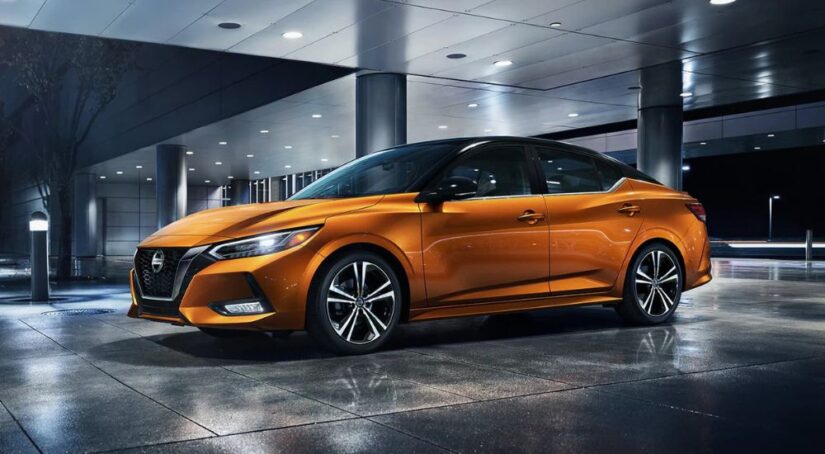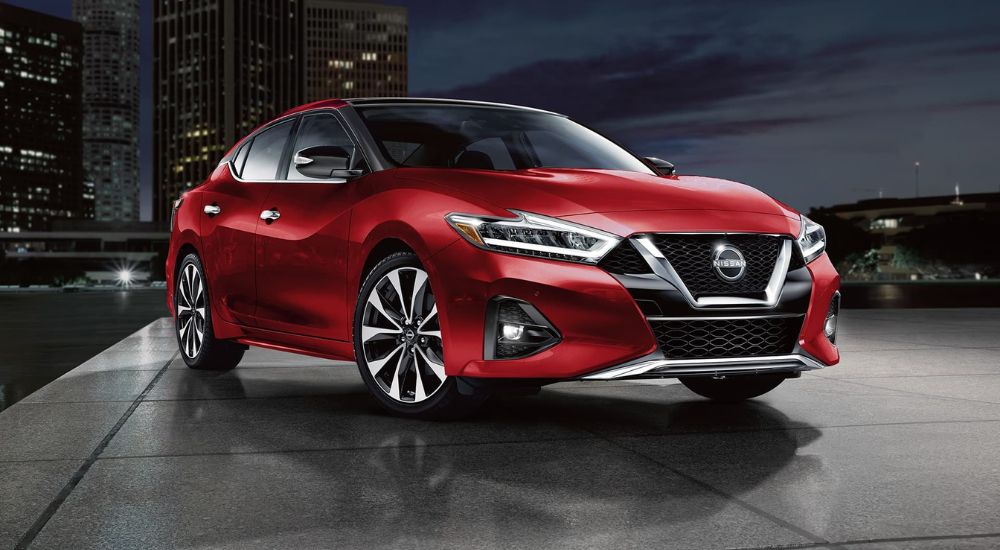Nissan is a Japanese automaker that can trace its roots all the way back to 1914. Over a century later, the company is still going strong and producing cars, crossovers, SUVs, and trucks that are reliable, stylish, and full of the latest tech features. Today, we’re going to be focusing on the brand’s current lineup of cars. If you’re a daily commuter, a fan of road trips, or looking to avoid pain at the pump, then the smaller body size and efficient engines of sedans are probably pretty appealing. Driving enthusiasts also tend to prefer cars over SUVs, thanks to their superior handling.
For the 2023 model year, Nissan has five different models for car buyers to choose from, not counting the Z and GT-R sports cars. These include the sleek 2023 Nissan Sentra, the green 2023 Nissan LEAF, and the sporty 2023 Nissan Maxima. These cars have a lot in common, but they also come in a range of sizes and offer different experiences when it comes to power, cargo space, and standard features. If you’re not sure which one is right for you, you’ve come to the right place. Let’s take a look at what Nissan’s cars have to offer.
Nissan Versa
The Versa is the most affordable option in Nissan’s lineup, with a starting MSRP of $15,830, making it a good choice for drivers on a budget. Its efficient powertrain, able to deliver up to 40 MPG on the highway and 32 MPG in the city, can continue to save you money on fuel over time. Its trunk provides 14.7 cubic feet of cargo space, and it can fit up to five passengers. Its 1.6-liter I-4 engine delivers up to 122 horsepower, which will get you where you need to go, but it is a lower figure than what you’ll find on the other Nissan cars.
Plenty of driver assistance technology comes standard. Even on the basic S trim, the Versa comes with Forward Collision Warning, Automatic Emergency Braking, Lane Departure Warning, and High Beam Assist. Higher trims also include features like Blind Spot Warning, Rear Cross Traffic Alert, and Intelligent Cruise Control. If you’re a thrill-seeker looking for a sporty ride, then this one probably isn’t for you, but if you’re looking for a practical vehicle and good value, then the Versa is worth considering.
Nissan Sentra
The Sentra is a step up from the Versa in terms of both style and power. Its 2.0-liter direct injection engine can provide up to 149 horsepower, and its exterior has a modern style with plenty of sharp angles and an intricate front fascia design. While the Sentra is a bit bigger than the Versa, it’s still a nimble compact sedan that’s designed to maneuver well on tight urban streets. It has a little less trunk space, at 14.3 cubic feet, but more leg room in the back seat so passengers can stretch out and get comfortable. The Sentra also comes standard with more driver assistance tech than the Versa. Blind Spot Warning, RearView Monitor, Rear Sonar System, and Intelligent Driver Alertness all come standard on the base S trim. Nissan’s Xtronic CVT automatic transmission also comes standard on the Sentra, which doesn’t offer manual transmission as an option.
Nissan Altima
Moving up to the midsize sedan category, the Altima has 15.4 cubic feet of cargo space in the trunk and more head and shoulder room for passengers in the front and rear rows than the Sentra. The Altima can be had with either the same 2.5L Direct Injection engine available on the Sentra or a 2.0L VC-Turbo engine that comes standard on the SR VC-Turbo trim and can deliver up to 248 horsepower. The 2023 Altima has been named a Top Safety Pick+ by the Insurance Institute for Highway Safety thanks to its crashworthiness and included crash avoidance and mitigation technologies.
One feature available on the Altima that’s not an option on the Versa or Sentra is ProPilot Assist. This advanced driver assistance tech partially automated highway driving in certain circumstances. It’s not true self-driving, and you need to pay attention at all times while using it, but it can keep you centered in your lane, both when the road is straight and when it gently curves, and slow down and speed back up in order to maintain a set minimum distance between you and the vehicle in front of you.
Nissan LEAF
While all of the other cars on this list are powered by gas engines, the LEAF is an EV with a fully electric powertrain. Two batteries are available for the 2023 LEAF. The base option is a 40 kWh battery that gives the LEAF a range of up to 149 miles between charges and delivers up to 147 horsepower. For more power and more time between charges, you can opt for the 60 kWh battery, which has an estimated range of up to 212 miles and is rated at 214 horsepower.
With an available portable charging cable and a 240-volt outlet, you can charge the LEAF at home and let it power up overnight. The 40kWh battery should reach a full charge in 7.5 hours, while the 60kWh battery takes about 11 hours to reach a full charge using a 240-volt outlet. In a pinch, the LEAF can also be charged from a standard 120-volt outlet, but it’s the slowest option and not really recommended as a permanent solution. If you’re on the go, some LEAF models are compatible with public DC fast charging, which is the fastest option and can get the battery up to 80% capacity in about 40-60 minutes. You can use the NissanConnect app to check your charging status from a distance.
The LEAF is a hatchback, not a sedan. That means that it has an open cargo area in the back instead of a sealed trunk. This can be a pro if you want to be able to transport bulky items like furniture or bring your big dogs along for the ride, but a con if you want to keep all of your cargo secure and out of sight while parked. The LEAF provides 23.6 cubic feet of cargo space with the rear seat up and 30 cubic feet of cargo space with the back seat folded down.
Nissan Maxima
If you’re looking for a more thrilling driving experience, then the so-called “four-door sports car,” aka the Maxima, is worth considering. All trims come standard with a 3.5L V6 engine that can produce up to 300 horsepower and 261 lb-ft of torque. While the sleek exterior is designed to be aerodynamic and efficient, the interior still has a good amount of space, and the trunk can fit 14.3 cubic feet of cargo. As an IIHS Top Safety Pick+, the 2023 Maxima is also a safe and reliable choice.
The base SV trim comes standard with a good range of comfort and convenience features, including dual-zone automatic climate control, push-button ignition, an eight-way power driver’s seat with power lumbar support, and heated seats in the front row. If you want paddle shifters so you can manually change gears despite the Maxima’s automatic transmission, you’ll have to upgrade to the SR trim. The top-tier Platinum Maxima adds a power-tilt/telescoping steering column, rain-sensing windshield wipers, and heated rear seats.
Which One Is Right for Me?
If you like what Nissan has to offer but aren’t sure which model is the best fit, then there are a few things to consider. First is your price range. While the Maxima offers plenty of power and premium features, it also has a much higher sticker price than the Versa. You also want to keep your driving habits in mind. If you’re just looking for something to commute to the office in every day, then the LEAF’s range might be plenty for you, but if you like longer road trips, then the Sentra might make more sense.
If there are multiple options that would work for you, then it’s time to simply trust your gut. Take a test drive in both and see which one feels better, or choose the one with styling that matches your taste. If you don’t feel 100% confident in your choice, you can always consider a short-term lease that gives you a chance to reassess your decision after a few years.





